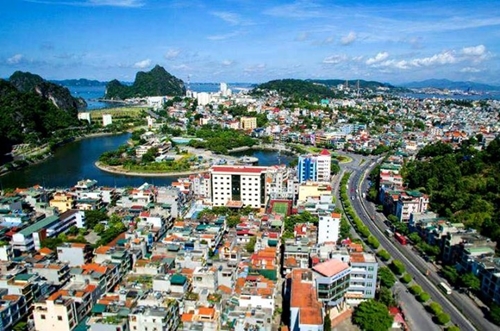The adjustments were approved in the Prime Minister’s Decision 702/QD-TTg issued on June 7 this year.
The adjustments are made with the goal of enhancing the role and position of Quang Ninh province in general and Ha Long city, home to the World Heritage site of Ha Long Bay, in particular. They are designed to help Ha Long develop in a sustainable manner, meeting requirements of green growth and adaptation to climate change.
    |
 |
|
A corner of Ha Long city (Photo: baochinhphu.vn) |
Ha Long is envisioned to become a modern and friendly sea resort city and an international-class service-tourism center, in tandem with preserving and promoting the value of the Ha Long Bay.
The area subject to the planning covers 27,753.9 ha of land within the administrative boundary of Ha Long city, with some adjacent localities also targeted for research.
Ha Long city, projected to have a population of 570,00-600,000 by 2030, will be developed under the model of a multi-polar city. The Cua Luc Bay will be the center of connectivity, while urban development will focus on the corridor along the coast of Ha Long Bay, divided into four zones.
In the North, there will be an urban area connecting with the natural ecological system of Cua Luc Bay; while in the South, the Southern Hoanh Bo area in Hoanh Bo district will be turned into an eco-service urban areas supporting Ha Long city.
The development zone in the east will serve as the city’s administrative, commercial and cultural center, and the western zone will accommodate tourism, service, industry and port. Further to the west there will be international-class tourism-service centers and education and sport facilities in combination with urban areas.
Regarding directions for industrial production, the city will shift to industrial clusters and logistic and storage services. It will build the Viet Hung hi-tech park, turn the Cai Lan industrial park into a hub of clean industries and in the long-term, a complex of urban and port services, and upgrade the Ha Khanh industrial cluster. Open mines will be restored and converted into greenery, golf courses, tourism site and ecological urban areas.
For the tourism sector, Ha Long city will develop entertainment facilities, high-class resorts, marinas, cruiser ports meeting international standards in the Bai Chay-Hung Thang areas. Cultural tourism will be developed in Hon Gai, while eco-tourism and resort facilities are planned for Tuan Chau and Dai Yen areas.
The city aims to attract investment in high-class hotels, resorts and entertainment parks. It will designate 524ha of land for building resorts, hotels and other types of accommodations.
It is noteworthy that public beaches and related services will be developed in coastal areas in Hong Gai, Hong Ha, Ha Phong, Cao Xanh, Bai Chay, Hung Thang and Tuan Chau.
At the announcement ceremony, Vice Chairman of the provincial People’s Committee Cao Tuong Huy required Ha Long city authorities to build detailed development plans based on the overall planning, along with schemes on attracting investment and arranging capital.
He instructed that priority should be given to areas and zones that can create quick and effective impacts on Ha Long’s overall development.
Huy added that the city should also revise previous plans to make them in line with the adjusted overall planning and quickly build regulations and necessary tools to ensure that the implementation of the adjusted planning meets schedule.
Ha Long is the capital city and first-class provincial city of Quang Ninh province. The city was created in 1993, when the old capital, Hon Gai, was merged with Bai Chay – the main tourist area. The city mainly lies on Ha Long Bay. It is located at about 178 km East of Hanoi.
Source: VNA